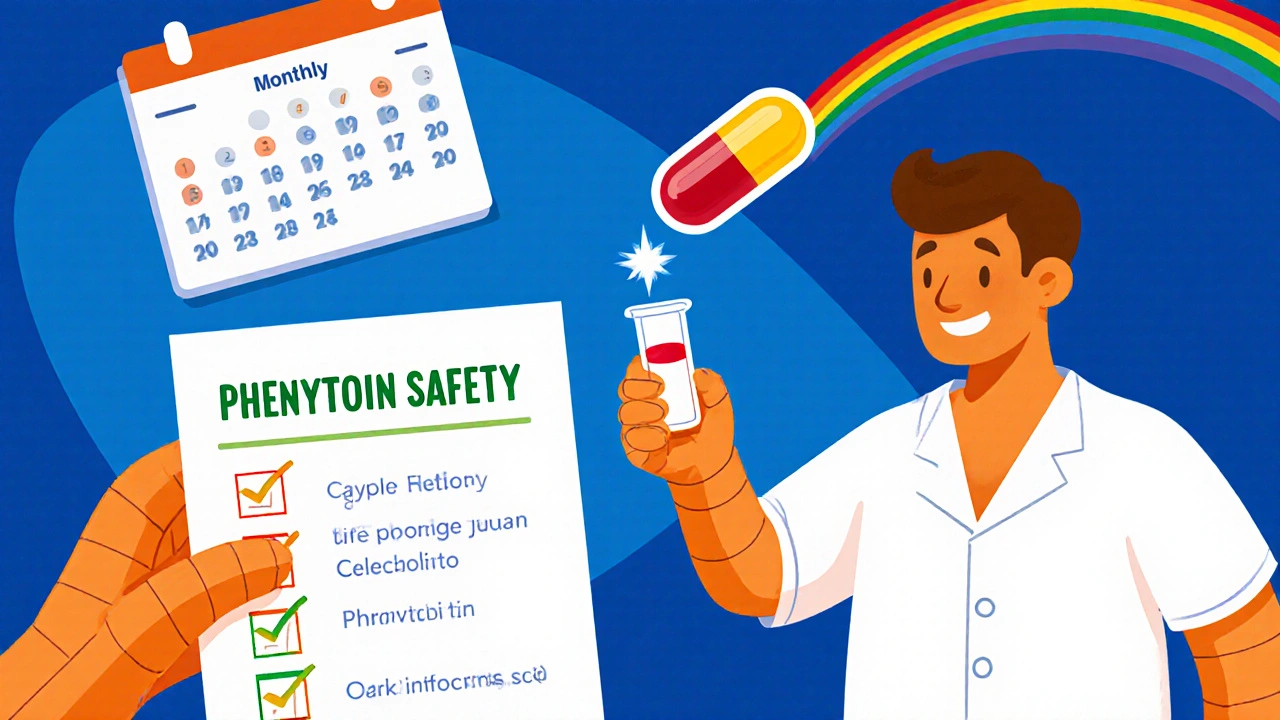
Phenytoin Therapeutic Range Calculator
When you’re on Phenytoin a widely used anti‑seizure medication, keeping an eye on how much of the drug sits in your bloodstream can mean the difference between seizure control and serious side effects. phenytoin blood level monitoring isn’t just a lab check; it’s a safety net that helps you and your clinician stay in the therapeutic zone.
What Therapeutic Drug Monitoring Means for Phenytoin
Therapeutic drug monitoring the practice of measuring specific drug concentrations in blood to maintain a constant, effective level is especially important for medications with a narrow therapeutic range. Phenytoin’s effective window (usually 10-20 µg/mL) is tight, and its metabolism is erratic, so the same dose can lead to very different blood concentrations from one person to another.
Why the Blood Level Can Fluctuate
- Enzyme variability: Phenytoin is broken down mainly by the liver enzyme CYP2C9 and, to a lesser extent, CYP2C19. Genetic differences in these Cytochrome P450 enzymes cause some patients to clear the drug quickly while others metabolize it slowly.
- Enzyme induction: Other medicines-like carbamazepine, rifampin, or even high‑dose oral contraceptives-can speed up phenytoin metabolism, dropping blood levels unexpectedly.
- Liver or kidney function: Impaired Liver function reduces clearance, raising the risk of toxicity; poor Kidney function can affect protein binding and distribution.
- Age and weight: Children, elderly patients, and those with significant weight changes often need dose tweaks.
- Nutrition and lifestyle: High‑protein meals, alcohol intake, and supplements like vitamin K or folic acid can alter serum concentrations.
Understanding the Therapeutic Range
| Serum Level (µg/mL) | Clinical Interpretation | Typical Symptoms |
|---|---|---|
| Less than 10 | Sub‑therapeutic | Breakthrough seizures, anxiety, irritability |
| 10 - 20 | Therapeutic | Seizure control with minimal side effects |
| Greater than 20 | Potentially toxic | Dizziness, nystagmus, ataxia, gum hyperplasia, cardiac arrhythmias |
These numbers are guides, not absolutes. Your clinician will consider the whole clinical picture-how you feel, seizure frequency, and any side effects-when interpreting the results.
When to Get Your Blood Tested
- After initiating therapy: Measure 2-3 weeks after the first dose to see where you land.
- When adjusting the dose: Re‑check 1 week after any change, then again after a steady‑state period (about 5 half‑lives, roughly 2 weeks).
- During pregnancy: Hormonal shifts can double phenytoin clearance; monthly checks are common.
- If you start or stop interacting drugs: Enzyme inducers or inhibitors require a new baseline.
- When symptoms change: New dizziness, gum overgrowth, or uncontrolled seizures warrant an immediate test.
How to Prepare for the Test
- Fast for at least 2 hours unless your doctor says otherwise.
- Keep a record of all medications, supplements, and recent alcohol consumption.
- Bring a copy of your latest seizure diary; patterns can help explain abnormal levels.
Interpreting Results and Dose Adjustment
If the serum level is below the therapeutic window, your doctor may increase the dose by 30-50 mg and repeat the test after a week. For levels above 20 µg/mL, the dose is usually cut by 25-30 % and the patient is monitored closely for improvement in side effects.
Because phenytoin follows nonlinear (Michaelis‑Menten) kinetics at higher concentrations, small dose changes can produce large swings in blood level. That’s why regular monitoring is essential whenever you’re fine‑tuning the regimen.

Common Drug Interactions to Watch
- Enzyme inducers: Carbamazepine, phenobarbital, rifampin - lower phenytoin levels.
- Enzyme inhibitors: Amiodarone, cimetidine, fluconazole - raise levels.
- Protein‑binding competitors: Warfarin and highly albumin‑bound drugs can displace phenytoin, increasing free (active) concentration.
- Alcohol: Acute binge can temporarily boost toxicity; chronic use may increase metabolism.
Always list new prescriptions or over‑the‑counter meds with your neurologist. Even “harmless” supplements like vitamin K or folic acid can shift the balance.
Special Populations
- Pregnant women: Phenytoin clearance can rise 30-50 % in the second trimester. Monitoring at least once per month helps keep seizures under control while avoiding fetal toxicity.
- Elderly patients: Reduced hepatic mass and protein binding increase free drug. Start low, go slow, and test more frequently.
- Patients with renal or hepatic disease: Dose reductions of 25-50 % are common; frequent labs are a must.
What Happens If Monitoring Is Skipped?
Skipping tests can let sub‑therapeutic levels go unnoticed, leading to breakthrough seizures-or worse, allow toxic levels to accumulate, causing neuro‑cognitive slowing, heart rhythm problems, or severe gum overgrowth. In extreme cases, high phenytoin levels have been linked to (rare) Stevens‑Johnson skin reactions.
Quick Checklist for Phenytoin Patients
- Keep a personal log of doses, side effects, and seizure events.
- Schedule blood draws after any dose change, new medication, or pregnancy milestone.
- Fast before the test unless instructed otherwise.
- Bring a complete medication list to every appointment.
- Discuss any lifestyle changes-alcohol, diet, supplements-with your clinician.
Bottom Line
Phenytoin saves lives, but its narrow therapeutic window makes blood level monitoring a non‑negotiable part of safe treatment. By staying on top of the numbers, you give yourself the best chance of seizure freedom without paying the price of toxicity.

How often should a stable phenytoin patient get blood level checks?
If you’re on a stable dose and no new drugs have been added, most clinicians recommend checking the level every 6‑12 months. Any change in health status, pregnancy, or medication warrants a sooner test.
What symptoms suggest phenytoin toxicity?
Common signs include nystagmus (rapid eye movement), ataxia (loss of coordination), dizziness, slurred speech, and gum overgrowth. Cardiac arrhythmias are rare but serious.
Can diet affect phenytoin levels?
A high‑protein or high‑fat meal can slightly increase absorption, while chronic alcohol use may either raise or lower levels depending on timing. Consistency is key-eat similar meals before each test.
Is it safe to stop phenytoin abruptly?
No. Sudden discontinuation can trigger severe seizure recurrence and even status epilepticus. Tapering should be done under medical supervision, with repeat level checks.
Do over‑the‑counter supplements interact with phenytoin?
Yes. Vitamin K, calcium, and folic acid can change protein binding, while herbal products like St. John’s wort induce metabolism. Always inform your healthcare team before adding any supplement.

 Health and Wellness
Health and Wellness
Devendra Tripathi
October 21, 2025 AT 12:25People act like blood levels are the holy grail, but most of the time they just chase numbers. The narrow therapeutic window of phenytoin makes those numbers fickle, shifting with a single enzyme mutation. You can’t trust a single draw to represent your whole pharmacokinetic picture. That’s why clinicians need a series of checks, not a one‑off snapshot. If you treat the lab result as gospel, you’ll end up over‑adjusting and courting toxicity.
Brandy Eichberger
November 1, 2025 AT 13:07Ah, the elegance of therapeutic drug monitoring lies in its ability to translate biochemical nuance into clinical confidence. By anchoring dosage adjustments to concrete serum concentrations, we preserve seizure control while sidestepping adverse effects. Consistency in fasting protocols and timing of draws further refines the data’s reliability. It’s a dance of precision that demands both patient diligence and physician insight. When executed properly, it elevates care from guesswork to art.
Eli Soler Caralt
November 12, 2025 AT 14:50The bloodstream is a mirror, reflecting the inner alchemy of our bodies and the external forces that shape them. Each phenytoin molecule, once released, embarks on a journey governed by enzymes, diet, and the silent whispers of genetics. When CYP2C9 smiles, the drug fades like dusk, leaving the patient vulnerable to the night of seizures. When CYP2C19 frowns, concentrations swell, and the world tilts under the weight of dizziness and gum overgrowth. 🌌
We are not mere vessels; we are ecosystems where vitamins, alcohol, and even the moon’s cadence modulate absorption. A high‑protein feast can nudge levels upward, while chronic ethanol may coax the liver into a hyper‑metabolic stance. 🌿
Pregnancy, that grand metamorphosis, rewrites the script, accelerating clearance and demanding monthly chapters of monitoring. Each new prescription is a plot twist-carbamazepine a rogue antagonist, fluconazole a covert ally-shifting the balance in unseen ways. 🎭
Thus, the act of drawing blood is a ritual, a communion with our own physiology, a moment to pause and listen to the silent feedback of our cells. The data it yields is not a verdict but a dialogue, guiding the clinician’s hand with humility. In the grand tapestry of epilepsy management, monitoring is the thread that weaves safety, efficacy, and hope into a cohesive whole. 🌟
Eryn Wells
November 23, 2025 AT 16:33Monitoring phenytoin isn’t just for doctors; it’s a shared responsibility that bridges cultures and communities. By keeping a simple log of doses, side‑effects, and any new supplements, patients empower themselves and their care teams. Remember to bring that list to every appointment, no matter how routine it feels. 🌍💙
Kathrynne Krause
December 4, 2025 AT 18:16Hey folks, think of your phenytoin levels as a colour palette-too dull and seizures flare, too bright and side‑effects scream. Mix in steady routine, balanced diet, and regular labs, and you’ll paint a masterpiece of seizure control. 🌈💪
Vivian Annastasia
December 15, 2025 AT 19:59Oh great, another reminder that you have to bleed for numbers. If you’re already juggling meds, adding blood draws feels like a hobby. The “safety net” they brag about is just a cheap excuse to keep the labs rolling.